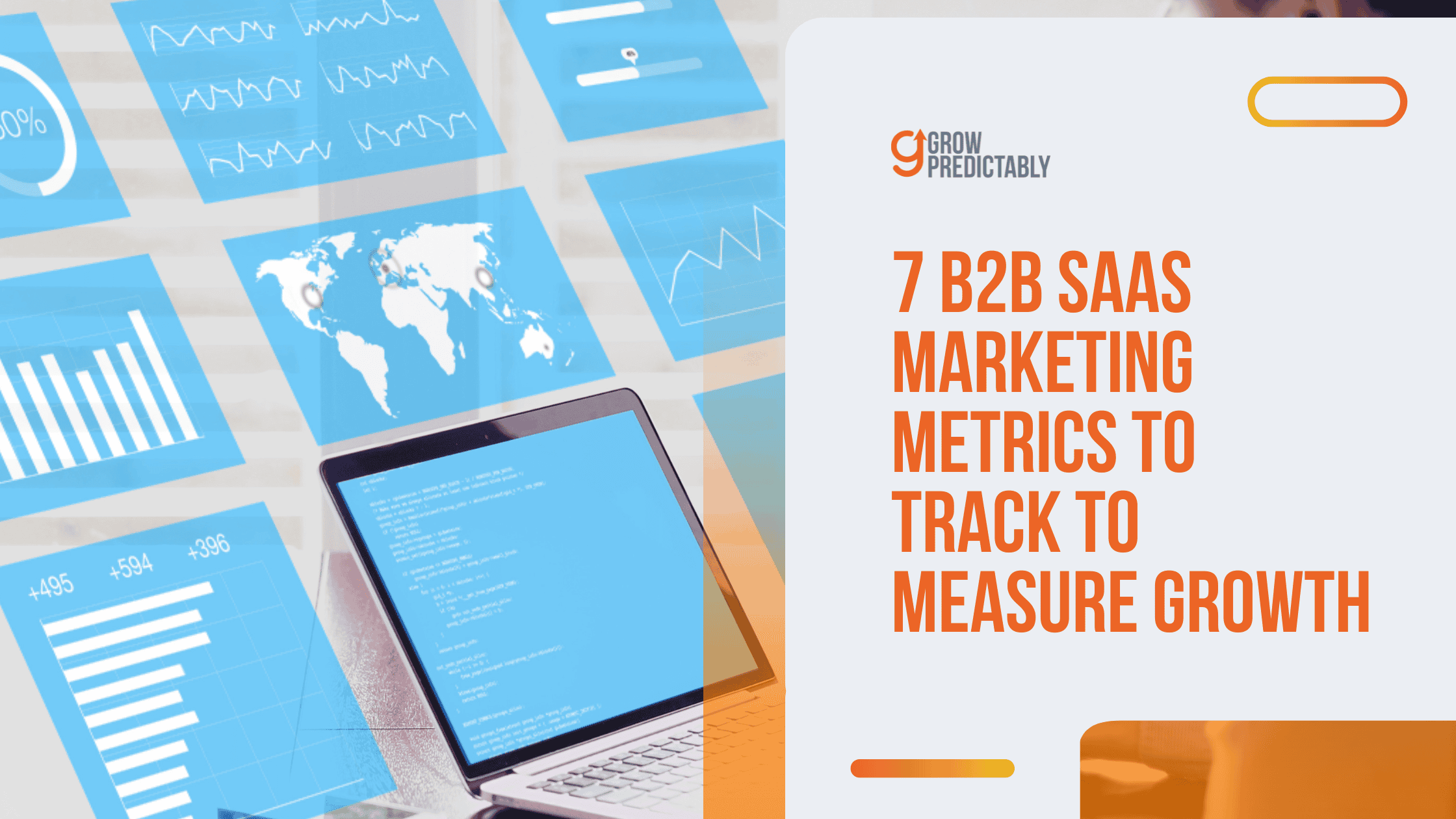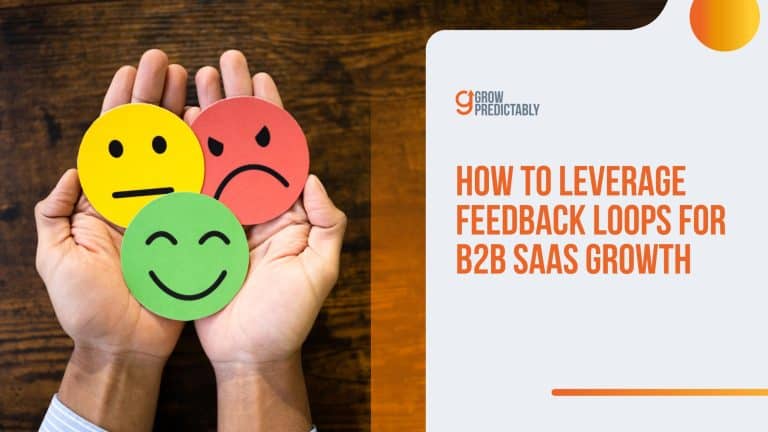7 B2B SaaS Marketing Metrics to Track to Measure Growth
If you’ve ever wondered, “How can I effectively measure progress in marketing?” know that you’re not alone.
It’s a common scenario at the end of marketing campaigns.
It can be very intricate because the numbers tell you whether your marketing campaigns yield the desired results or not.
Speaking of numbers, did you know that for SaaS companies, a benchmark for strong performance is a 30% MRR growth rate for large companies?
For small SaaS companies, it’s different.
So, how do you think you are holding up to this benchmark?
It’s a tricky question, huh? But don’t sweat it.
If you often find yourself in the same situation, especially regarding your B2B SaaS marketing metrics, this post has something for you.
Analyzing data isn’t just about decoding what the numbers tell you; they also serve as your ammo for smarter decision-making.
That’s why you need to break through the data fog.
Today, we will tackle 5 B2B SaaS marketing metrics you need to track to measure growth.
If you’re ready to achieve marketing zen in your SaaS business, read through.
- Effective B2B SaaS marketing efforts rely on understanding key metrics like Customer Acquisition Cost (CAC), Customer Lifetime Value (LTV), churn rate, Lead Conversion Rate, and Monthly Recurring Revenue (MRR) to optimize strategies and demonstrate ROI.
- Applying these metrics means setting specific goals, monitoring relevant data, and making adjustments as necessary to improve strategies while avoiding the pitfall of focusing solely on vanity metrics.
- To efficiently track and analyze these metrics, utilize the appropriate tools and resources ranging from free platforms like Google Analytics to more advanced CRM systems, and enhance your skills through webinars and online courses.
7 B2B SaaS Marketing Metrics You Need to Track

If you want to scale your B2B SaaS company, you need to see metrics as your secret weapon.
Think of them as your map, compass, and treasure chest rolled into one, guiding you to marketing glory.
With so many numbers flying around, you should start with these:
1. Customer Acquisition Cost (CAC)
How much does it take to land a new customer? This metric helps you optimize your marketing spend, ensuring you’re not spending a fortune to acquire someone worth a penny.
To calculate your CAC, here is the formula:
CAC = (cost of sales + cost of marketing) / new customers acquired
Example: Imagine your SaaS business spent $10,000 on sales and $15,000 on marketing in a month and acquired 100 new customers.
Step-by-Step:
- Add the cost of sales and the cost of marketing: $10,000+$15,000=$25,000$10,000+$15,000=$25,000
- Divide the total cost by the number of new customers acquired: $25,000100=$250100$25,000=$250
Your Customer Acquisition Cost is $250.
This means you spend $250 to acquire each new customer, which helps you gauge if your marketing and sales efforts are cost-effective.
2. Customer Lifetime Value (LTV)
Think of this as the golden goose – how much average revenue a customer brings in their customer lifetime.
Comparing LTV to CAC tells you if your paying customers are worth their weight in gold (or just pyrite).
To calculate your CLT, here is the formula:
CLT = customer value x average customer lifespan
Example: If the average customer spends $50 per month and stays with your service for 2 years (24 months).
Step-by-Step:
- Calculate the customer value: $50×24=$1,200$50×24=$1,200
Your Customer Lifetime Value is $1,200.
This means each customer is expected to bring in $1,200 over their lifetime, helping you understand their long-term value compared to your acquisition cost.
3. Customer Churn Rate
Customers come and go, but losing too many too fast spells trouble.
Tracking customer churn helps you understand why customers say goodbye and take action to keep them happy.
To calculate the Customer Churn Rate, here is the formula:
CCR = (lost customers / total customers at the start of the period) x 100
Example: If you started the month with 500 customers and lost 50 customers.
Step-by-Step:
- Divide the number of lost customers by the total customers at the start of the period: 50500=0.150050=0.1
- Multiply by 100 to get the percentage: 0.1×100=10%0.1×100=10%
Your Customer Churn Rate is 10%.
This indicates that 10% of your customers are leaving each month, signaling a potential issue with customer satisfaction or product value.
4. Lead Conversion Rate
Converting leads to paying customers is the holy grail of your marketing efforts.
This metric shows how well your lead magnets and nurturing campaigns work on a sales qualified lead or a marketing qualified lead, turning prospects into loyal fans.
To calculate your LCR, here is the formula:
LCR = number of new customers/number of leads ( x 100 )
Example: If you had 200 leads and converted 40 of them into new customers.
Step-by-Step:
- Divide the number of new customers by the number of leads: 40200=0.220040=0.2
- Multiply by 100 to get the percentage: 0.2×100=20%0.2×100=20%
Your Lead Conversion Rate is 20%.
This shows that 20% of your leads turn into paying customers, reflecting the effectiveness of your marketing and sales strategies.
5. Monthly Recurring Revenue (MRR)
Predictable income? Yes, please! MRR shows your consistent revenue stream from subscriptions, representing financial stability and growth potential.
To calculate your MRR, here is the formula:
MRR = number of active accounts or monetizable users x average revenue per account monthly billing
Example: If you have 300 active accounts, each paying $30 per month.
Step-by-Step:
- Multiply the number of active accounts by the average revenue per account: 300×$30=$9,000300×$30=$9,000
Your Monthly Recurring Revenue is $9,000.
This consistent income helps you predict financial stability and plan for growth.
6. Customer Retention Rate (CRR)
Keeping paying customers happy and loyal is key to sustainable growth.
This metric shows how well you maintain your customer base over time, which is crucial for long-term success.
To calculate your CRR, here is the formula:
CRR = [(customers at the end of the period – new customers during the period) / customers at the start of the period] x 100
Example: Imagine you started the month with 400 customers, acquired 50 new customers, and ended the month with 420 customers.
Step-by-Step:
- Subtract the number of new customers from the number of customers at the end of the period: 420 – 50 = 370
- Divide by the number of customers at the start of the period: 370 / 400 = 0.925
- Multiply by 100 to get the percentage: 0.925 x 100 = 92.5%
Your Customer Retention Rate is 92.5%.
This means that you retained 92.5% of your customers over the month, indicating strong customer loyalty and satisfaction with your service.
7. Annual Recurring Revenue (ARR)
For a long-term view of financial stability and growth, ARR represents the annualized revenue from your subscriptions, giving you a clear picture of your business’s recurring income over a year.
To calculate your ARR, here is the formula:
ARR = Monthly Recurring Revenue (MRR) x 12
Example: If your Monthly Recurring Revenue (MRR) is $10,000.
Step-by-Step:
- Determine your MRR. This is the total revenue you earn from subscriptions in a month. In this example, it is $10,000.
- Multiply the MRR by 12 to annualize it:
- Monthly Recurring Revenue (MRR) = $10,000
- Calculation: $10,000 x 12 = $120,000
Your Annual Recurring Revenue is $120,000.
This annualized metric helps you forecast long-term revenue, assess the financial health of your business, and plan for future investments and growth.
There you have it: the seven essential marketing metrics in SaaS that need tracking.
But these are just the starting points.
Understanding industry benchmarks and best practices for each metric also helps you set realistic goals and track your progress like a pro.
Remember, knowledge is power, and when it comes to metrics, it’s the power to unlock explosive growth for your B22 SaaS company.
So, go forth and conquer those numbers!
Understanding Cohort Analysis in B2B SaaS Marketing Metrics
In the fast-paced world of B2B SaaS, precision is key.
Cohort analysis paired with the Customer Avatar Canvas is your strategy powerhouse, offering insights that elevate your approach to marketing metrics and customer understanding.
What is Cohort Analysis?
Cohort analysis allows you to identify patterns by examining groups of paying customers who exhibit shared characteristics over time.
This approach transforms data into meaningful insights about how these users interact with your SaaS company, revealing trends that can guide your strategies.
What is a Customer Avatar?
Your customer avatar is a detailed depiction of your target audience.
It’s about knowing your customers inside and out—how they think, what they need, and how they define customer success.
The Customer Avatar Canvas gives you a structured way to capture this information and align your business approach.

Leveraging Customer Avatars in Cohort Analysis
- Personalized Insights: By integrating cohort analysis with customer avatars, you understand user interactions clearly. This alignment shows you how each customer acquisition effort matches real-world engagement.
- Targeted Strategy Development: Create a marketing strategy that’s precisely aligned with each avatar. Every marketing and sales effort becomes targeted, driving improvements in conversion rates and customer retention.
- Enhanced Segmentation: Customer avatars allow you to pinpoint distinct segments within your cohorts. This detailed segmentation provides a fine-tuned approach to developing strategies based on specific behaviors and needs.
- Improved Product Development: Use insights from these techniques to shape your product roadmap. You’re not just adding features; you’re developing solutions that directly address the needs highlighted by your avatars, enhancing customer success.
- Optimized Marketing Messages: Craft messages tailored to each avatar. Knowing how different segments respond allows you to create content and calls to action that consistently resonate with your audience.
How to Implement This Combined Approach
- Define Cohorts and Avatars Together: Begin by mapping out your cohort groups alongside distinct customer avatars. This approach provides a comprehensive view of behaviors and characteristics across your user base.
- Choose Relevant Metrics: Focus on key metrics for each avatar within your cohorts, such as churn rate or LTV. Track these metrics meticulously to gain insights into performance.
- Integrate Insights into Strategy: Apply these insights to refine your marketing and product strategies. If a specific avatar cohort indicates high churn, investigate and address the underlying issues to improve engagement.
- Iterate and Optimize: Continually update and refine your customer avatars based on cohort analysis findings, ensuring they remain accurate representations of your evolving audience.
Combining cohort analysis with the Customer Avatar Canvas creates a powerful toolset for understanding and addressing your customers’ needs.
This approach not only leads to more effective strategies but also fosters stronger engagement and success across your SaaS company’s offerings.
Your sales team and entire organization will benefit from this deeper understanding and focused approach.
5 Benefits of Using Marketing Metrics for B2B SaaS
Are you a B2B SaaS company looking to boost your growth?
Discover the power of using marketing metrics to track your success and make informed decisions.
From improving ROI to understanding customer behavior, harnessing these metrics can take your business to the next level.
- Optimize Marketing Spend: By tracking metrics like Customer Acquisition Cost (CAC), you can ensure that your marketing budget is spent efficiently, targeting the most cost-effective channels and strategies.
- Improve Customer Retention: Metrics such as Customer Churn Rate help you understand why customers leave and allow you to implement strategies to improve retention and reduce churn.
- Enhance Lead Quality: Monitoring the Lead Conversion Rate (LCR) helps you identify the most effective tactics for converting leads into paying customers, improving the overall quality of your leads.
- Forecast Revenue Growth: Monthly Recurring Revenue (MRR) and Customer Lifetime Value (LTV) provide insights into your predictable income and long-term revenue potential, helping you make informed financial forecasts.
- Data-Driven Decision Making: Consistently tracking and analyzing these metrics enables you to make informed, data-driven decisions that can simplify your marketing strategies and drive growth.
These metrics empower you to make smarter marketing choices, fostering sustainable growth and ensuring your B2B SaaS company remains competitive.
5 Steps to Get Your Metrics Moving
Once you’ve become familiar with these important metrics, the subsequent action is to implement them.
This process includes establishing objectives, handpicking pertinent metrics, and tracking progress.

It’s essential to recognize that while these metrics offer significant insights into your marketing strategy’s effectiveness, they do not solely dictate its success or failure.
Instead, they should work in tandem with additional key indicators for a holistic assessment of your promotional activities.
To put your metrics into action, here’s how you can start:
Step 1: Set Measurable Goals
- Define your destination: What are your key SaaS company objectives? Is it to boost revenue, decrease churn, or acquire more sales qualified leads/marketing qualified leads? Establishing these targets is the first step toward effective metric optimization.
- Be precise: Transform broad ambitions into SMART goals: Specific, Measurable, Achievable, Relevant, and Time-bound. For instance, rather than “increase leads,” target “a 20% rise in qualified leads by Q2.”
- Align with the funnel: Connect your objectives to various stages of the marketing funnel (awareness, consideration, decision) to ensure you’re tracking the right metrics.
Step 2: Measure
- Choose wisely: Focus on metrics that directly relate to your goals and the marketing funnel stages.
- Key metrics to consider include:
- Acquisition: Track website traffic, lead generation rate, and cost per acquisition (CAC).
- Engagement: Monitor website engagement metrics (bounce rate, time on site), email open rates, and content downloads.
- Conversion: Monitor lead conversion rate (for both sales qualified lead and marketing qualified lead), customer acquisition cost (CAC), and customer lifetime value (LTV).
- Retention: Watch the churn rate, customer satisfaction score, and net promoter score (NPS).
- Benchmarking: Investigate industry averages to set realistic expectations for your metrics.
Step 3: Report
- Choose your tools: Select analytics platforms like Google Analytics and dashboards that effectively track your chosen metrics.
- Schedule reports: Regularly review your metrics (weekly, monthly) to monitor progress and identify trends.
Step 4: Extract Insights
- Interpret data: Analyze the data to understand what’s working well and what’s not. Look for patterns, anomalies, or trends that can inform your strategy.
- Act on insights: Use your findings to make informed decisions. If a particular channel or tactic is performing exceptionally well, consider allocating more resources to it.
Step 5: Optimize
- Adjust your strategy: Based on your insights, tweak your marketing strategies, tactics, or even your goals to ensure you’re on the right path to maximizing your marketing metrics.
- Continuous improvement: Your marketing efforts will always be an ongoing process. Regularly review and adjust your approach based on the latest data and insights to keep improving your results.
Remember: Be patient and constant. Data takes time to tell its story. By consistently setting goals, choosing relevant metrics, and tracking progress, you’ll transform data from daunting numbers into your B2B SaaS marketing compass, guiding you toward sustainable revenue growth and marketing nirvana.
TIP: Don’t go it alone! Share your data insights with your team to foster collaboration and data-driven decision-making.
5 Best Practices to Supercharge Your Metrics
We just touched on the essential metrics and steps needed to implement your marketing metrics.
But behind the process, you also need to have the right principles.
Here are five best practices you can turn into habits to supercharge the results you get from analyzing your B2B SaaS marketing metrics.

1. Be a Data Detective, Not a Hoarder: Don’t drown in a sea of numbers. Pick 5-7 key SaaS metrics aligned with your goals (think CAC, LTV, churn rate, lead conversion, MRR). These are your golden nuggets, not the whole mine.
2. Benchmark It Like Beckham: Don’t operate in a vacuum. Research industry benchmarks for your metrics. Are you lagging behind? Time to level up your game! Are you crushing it? High five, but keep innovating!
3. Tell Stories, Not Just Numbers: Data is powerful, but stories resonate. Translate your SaaS metrics into compelling narratives. Show how improved CAC led to customer engagement, happier customers, and higher profits. Make numbers come alive!
4. Don’t Go It Alone: Data is best shared. Foster a culture of data-driven decision-making across your marketing team. Marketing, sales, product – everyone should be on the same data-fueled page.
5. Experiment Like a Mad Scientist: Don’t be afraid to test and iterate. Try new marketing channels out, tweak campaigns, and analyze results. Remember, the best B2B SaaS marketers are data-driven risk-takers, not passive observers.
By following these tips, you’ll transform your metrics from confusing hieroglyphics into a clear roadmap to B2B SaaS marketing success.
BONUS: Use visualization tools like charts and infographics to make your data easy to understand and share. Remember, a picture is worth a thousand numbers (or at least a hundred!).
FAQs
Summary
Understanding your marketing metrics is vital in knowing what works and what doesn’t in your B2B SaaS marketing strategy.
Leveraging these metrics with precision can illuminate your marketing strategies and propel growth within your B2B SaaS enterprise.
Your metrics aren’t a resource to glance over briefly. You need to put it into practice!
Apply the strategies, steps, and best practices outlined to maximize every interaction with metrics truly.
Instead of getting intimidated by the complexity of these marketing metrics, you need to embrace them confidently.
Know that they can provide a strategic blueprint to how your SaaS solutions hold up in creating customer success for every user and improving overall customer retention.
Consider this: your path to leveraging data-driven growth starts with one decisive action—so why not embark on that path now?








